What’s driving turnover—and how comms pros can help stop the talent drain
Stephanie Sweet, vice president of PR and marketing communications for Robert Half, shares data on why workers are leaving their posts and what employers can do to keep them.
It’s being called “The Great Resignation,” and while some may have a quibble with the dramatic title, there’s no doubt about what the data says. A lot of workers have already left or are thinking about leaving their jobs, and there are more job openings than there are workers to fill the roles.
Stephanie Sweet, vice president of PR and marketing communications for Robert Half, the world’s first and largest specialized talent solutions firm, shared data her organization has collected on the current labor market on a recent call for Ragan’s Crisis Leadership Network.
At the top of the list, workers are looking for flexibility. The problem is that employers and would-be employees see the issue of flexibility very differently when considering the future of work.
Why the churn?
When looking at the numbers, 1 in 5 workers have left jobs or are in new jobs. “Workers have really reevaluated,” explains Sweet. “They found out a lot about their current companies. Can they work remotely? Do they have hybrid opportunities?”
And the trend is not slowing down with 1 in 3 workers saying they plan to look for a new role in 2021. “From an employer’s lens, that is a dangerous number,” Sweet says.
Making your workplace more attractive
What can an employer do to make their roles more attractive in an increasingly competitive marketplace? Sweet runs through some of the top options Robert Half has seen companies take so far:
- Offer a signing bonus. Maybe a potential new hire is waiting to get a year-end bonus from their current employer before making the switch, Sweet says. Forty-eight percent of employers say they are trying to sweeten the deal with a signing bonus.
- Offer more PTO. Offering higher salaries is just a starting place, Sweet warns. When looking at what else you can offer a potential new employee, PTO and work/life balance are increasingly important.
- Offer better job titles. According to Robert Half’s data, 40% of firms are trying to lure employees with better job titles. “Professionals value their job title and external visibility,” Sweet says. “Negotiating job titles is a huge trend right now. Employees are looking for more in order to climb the ladder.”
What do employees really want?
While a signing bonus and a job title are options that employers are already actively using to recruit and retain, employee desires aren’t so narrowly defined. In short, they want flexibility.
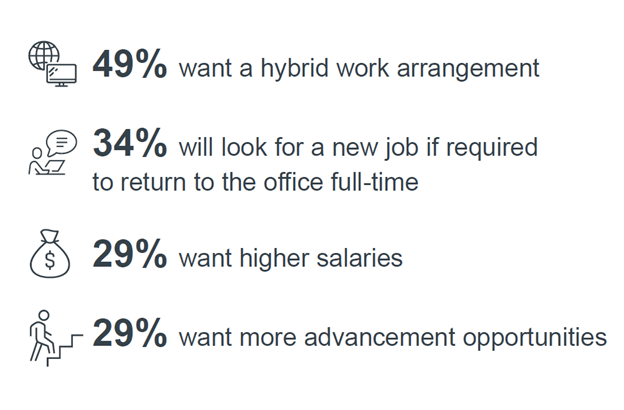
Sweet argues that many in the pandemic have reevaluated how work dominates their lives, whether they lose time to a commute or spend less time with kids and family. For workers who have discovered they can do their job from home—and in some cases be more productive—when the company asks them to come back to the office five days a week, they are ready to jump ship.
What’s holding employers back?
As to why employers are hesitant to offer remote work flexibility, Robert Half’s research offers some reasons:
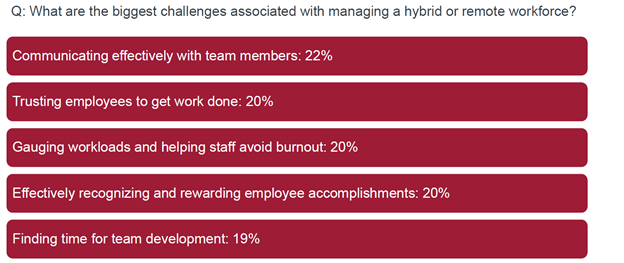
At the top of the list is effective communication and trusting employees to get work done. Other concerns are team development (19%) and effective employee recognition (20%).
But it’s not just the commute and flexible work that is driving employees to hit the exits. The pandemic also revealed much about an organization to employees, from priorities and care for workers to stances on structural racism and social inequality.
Here are some other shifting priorities that Robert half has identified at the root of employee departures:
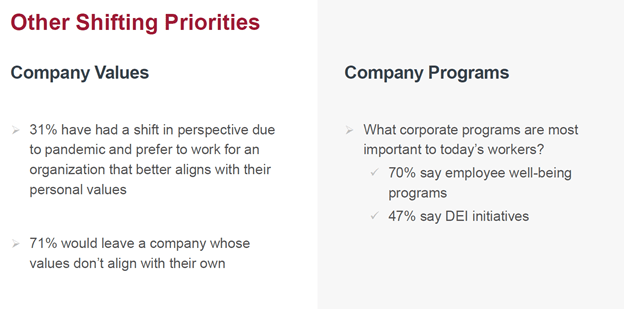
In order to stand out, Sweet and Robert Half offer four imperative actions:
1. Offer competitive pay and benefits. This is a “no-brainer” says Sweet, but it’s worth reminding employers that remuneration is still a top consideration for employees.
2. Continue to refine organizational culture. This all comes down to listening to and acting on what matters to your employees , Sweet says.
3. Embrace flexibility. Really ask yourself how flexible you can be, Sweet advises. The more flexible you are, the more options you will have to retain and recruit.
4. Make professional development plans. Workers are looking to advance and grow in their careers, Sweet says. Identify when someone is ready to take on new responsibilities and commit to getting them there.
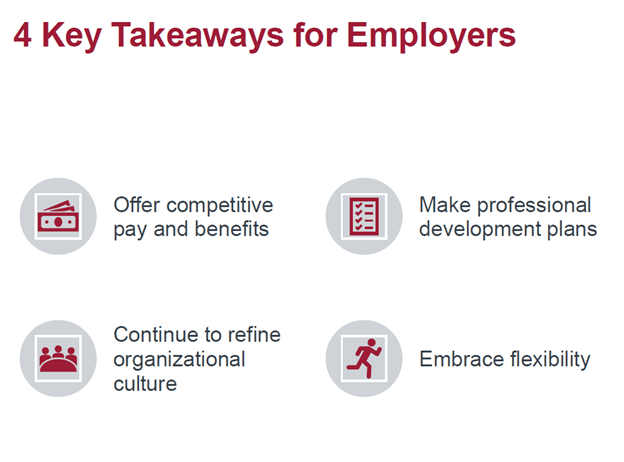
Finding diverse candidates
A top priority for many organizations in recent months has been sourcing diverse candidates, particularly as organizations have made increased DE&I commitments. For Robert Half, finding diverse candidates is all about building relationships with organizations working in those communities and being committed to building a pipeline.
“Our relationships with organizations that align with what we do are critical,” Sweet says.
It’s also important for employers to keep an open mind about candidates who might not have the exact job history or educational background that you would traditionally look for.
“Bring an open mind,” says Sweet. “Just because someone might not check every box doesn’t mean you are not going to find a successful match.”
Will pandemic burnout ever end?
If pandemic fatigue and burned out employees are part of what is driving the worker migration of the past few months, what does that mean about the future? Will employees who burned out at other organizations also leave your organization? Are we in a spiraling cycle, doomed to repeat itself?
Sweet doesn’t think so, but shares what the pandemic should teach employers taking in new talent.
- Employers must take responsibility for encouraging workers to unplug. Being home every day has its perks, but workers must also avoid blurring work and home life, Sweet says. One example is building the idea of “windows of work” where employees agree to be available to colleagues. And if you make flexibility an option, set boundaries so workers don’t feel obligated to always check in to catch missives from workers logging odd hours.
- The days of being married to the job are over. Sweet argues that many workers have “seen the light” after experiencing a dramatically different workday during the pandemic. Employers must accept the reality that top performers have choices, and they don’t want to go back to the old way of doing things.
When hiring, move fast
Sweet’s final advice for employers looking to fill vacant roles in today’s market is to speed up the process.
“Speed to hire’ is something we talk to clients about all the time,” she says. If you drag your feet, job seekers will move on or fall out of love with your opportunity. The time frame you have, realistically, from first interview to final decision? Two weeks.
“Companies are pulling the trigger faster because they don’t want to go through the process again,” says Sweet. Dilly-dally in moving through your hiring process, and your dream candidate will be gone when you go to make a hire.
For employers who worry that moving too fast will increase the risk of hiring the wrong candidate—a move that can be costly—Sweet argues that the problem can usually be identified early.
“When we talk about failed hires … what we find, the majority of the time is not that it’s a bad fit technically,” she says. Instead, it is usually a “soft-skills” or culture-fit issue.
For hiring managers, the priority must be to find the best candidate who fits the team and organization’s ethos—and then move quickly to make an offer before another company nabs them from under your nose.
Learn more about Ragan’s Crisis Leadership Network here.


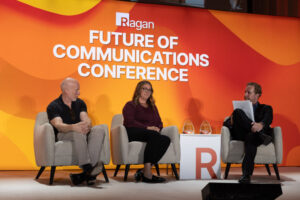





If you open the company’s annual donations list to permit contributions by employees, perhaps anonymous donations so no one feels pressured to give, you can month after month report in the company publication or site what “we”—our company—have been accomplishing and what letters of
thanks have been coming in. The more employees feel being “in this together” with others in the company, the more they have to feel like being part of something admirable.
Several times a year you may have something special to report from one of the good causes helped. Also several times you may have a commendation or letter of congratulations from political leaders of both parties. If ever the company is accused as most companies eventually are, sometimes several times, your own people will know what good things have been said about you.
If you not only acknowledge by mail the communications from good cause leaders and from political leaders, many of whom LOVE to see their picture in a company publication or on a website, and love it even more if given an
opportunity to make a very brief speech at some event, each quoted and pictured leader is in effect a company endorser! This is not only protective
if a company is accused but reduces the likelihood of accusation because activists prefer to attack vulnerable targets more than those that have been endorsed by admired leaders.
The more causes and leaders who endorse or thank a company, the more names you have that you can cite in your annual report to management of your results and your annual request for next year’s budget. If you get favorable comments from congressmen plus even senators and perhaps a governor, management may be delighted because many many senior execs have never seen PR do this before.
HR people take notice approvingly when someone in PR or any other department makes the most of what he or she has. It’s a delight for HR to find someone with that proclivity and ability.
HR people take notice approvingly when someone in PR or any other department makes the most of what he or she has. It’s a delight for HR to find someone with that proclivity and ability.